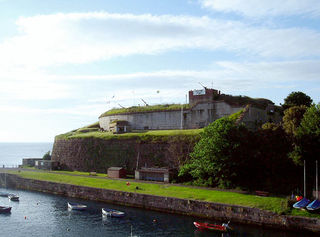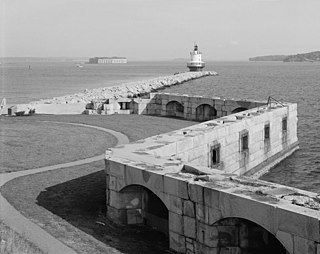
Blacknor Fort is a 20th-century fort on the Isle of Portland, Dorset, England. It is located at Blacknor Point on the western side of Portland, close to Weston village.

Blacknor Fort is a 20th-century fort on the Isle of Portland, Dorset, England. It is located at Blacknor Point on the western side of Portland, close to Weston village.

The fortress was built in 1900–02 as a coastal defence overlooking Lyme Bay to defend Portland Harbour and the other naval institutions on the island. The fort was operational during both World Wars with two 9.2-inch guns. During World War II, on the night of the 27 April 1944, the fort witnessed the Slapton Sands Massacre. As part of Exercise Tiger, United States soldiers were practising landings at Slapton Sands when they were attacked by German E-boats. The gunners at Blacknor Fort were ordered not to open fire for fear of hitting the Allied troops. More than 600 American soldiers and seamen drowned by the end of the night, many were pulled down by the weight of their own equipment. [1]
The fort was decommissioned in 1956 and is now privately owned and split into three separate properties, one of which was built on top of one of the two gun emplacements. [2] [3] Two small gun emplacements and an observation post survive outside the fort's perimeter on the cliff edge. [1]

Portland Harbour is located beside the Isle of Portland, Dorset, on the south coast of England. Construction of the harbour began in 1849; when completed in 1872, its 520-hectare (1,300-acre) surface area made it the largest human-made harbour in the world, and it remains one of the largest in the world today. It is naturally sheltered by Portland to the south, Chesil Beach to the west and mainland Dorset to the north. It consists of four breakwaters: two southern and two northern. These have a total length of 4.57 km (2.84 mi) and enclose approximately 1,000 ha of water.

Exercise Tiger, or Operation Tiger, was one of a series of large-scale rehearsals for the D-Day invasion of Normandy, which took place in April 1944 on Slapton Sands in Devon. Coordination and communication problems resulted in friendly fire injuries during the exercise, and an Allied convoy positioning itself for the landing was attacked by E-boats of Nazi Germany's Kriegsmarine, resulting in the deaths of at least 749 American servicemen.

Nothe Fort is a fort in Weymouth, Dorset, England, situated at the end of the Nothe Peninsula, which juts eastwards from the town of Weymouth, and Weymouth Harbour, into the sea to the north of the ex-military Portland Harbour. The fort is located next to Nothe Gardens.

The Verne High Angle Battery is a former 19th-century gun battery on the Isle of Portland in Dorset, England. Situated close to the Verne Citadel, the battery is Grade II Listed, and forms part of the citadel's scheduled monument status. The battery has become a tourist attraction, while the battery's tunnels are often referred to by their local name 'Ghost Tunnels'.
Weston is a village in Tophill on the Isle of Portland, Dorset, England. It abuts the main village Easton. As with the rest of Portland's villages and settlements, Weston has been designated as a conservation area, as it is a place of special architectural and historic interest. The village was designated in 1994.

Fort Preble was a military fort in South Portland, Maine, United States, built in 1808 and progressively added to through 1906. The fort was active during all major wars from the War of 1812 through World War II. The fort was deactivated in 1950. It is now on the campus of Southern Maine Community College.
Bincleaves Groyne is a breakwater located off the southern area of Weymouth, England. It is the second largest of four breakwaters which create Portland Harbour. It is separated from the Northeastern Breakwater by the North Ship Channel. A landing stage is situated on the southern side of the breakwater near the Western Ledges.

Torcross is a seaside village in the South Hams district of south Devon in England. It stands at grid reference SX822420 at the southern end of Slapton Sands, a narrow strip of land and shingle beach which separates the freshwater lake of Slapton Ley from Start Bay and carries the A379 coastal road north to Dartmouth.
Brixham Battery and Battery Gardens are an open space on the sea shore in Brixham, Devon at grid reference SX920569. They are a traditional observation point for Brixham trawler races, both past and present.
USS LST-507 was a LST-491-class tank landing ship built for the United States Navy during World War II. She was sunk by a German torpedo attack in April 1944 during Operation Tiger.

The Rodwell Trail is a short-distance footpath that runs from Wyke Regis to the town centre of Weymouth in Dorset – a distance of 2¼ miles. The trail, opened in 2000, travels along the former route of the Weymouth and Portland Railway. The section from near Sandsfoot Castle to Ferry Bridge is part of the South West Coast Path. The route follows part of the Jurassic Coast, and Sites of Special Scientific Interest. It is named after a neighbourhood of Weymouth which it passes through.

Fort Andrews was created in 1897 as part of the Coast Defenses of Boston, Massachusetts. Construction began in 1898 and the fort was substantially complete by 1904. The fort was named after Major General George Leonard Andrews, an engineer and Civil War commander, who assisted in the construction of nearby Fort Warren in Boston Harbor. It occupies the entire northeast end of Peddocks Island in Boston Harbor, and was originally called the Peddocks Island Military Reservation. Once an active Coast Artillery post, it was manned by hundreds of soldiers and bristled with mortars and guns that controlled the southern approaches to Boston and Quincy Bay. The fort also served as a prisoner-of-war camp for Italian prisoners during World War II, who were employed as laborers following the Italian surrender to the Allies in 1943. Today, the fort is abandoned, and is managed by the Massachusetts Department of Conservation and Recreation, as part of the Boston Harbor Islands National Recreation Area.

Fort Williams is a former United States Army fort in Cape Elizabeth, Maine which operated from 1872 to 1964. It was part of the Coast Defenses of Portland, later renamed the Harbor Defenses of Portland, a command which protected Portland's port and naval anchorage 1904–1950. After its closure, it was redeveloped into Fort Williams Park.

Nothe Gardens is a public garden, located in Weymouth, Dorset, England. Positioned on the Nothe Peninsula overlooking both Weymouth and Portland harbours, the informal gardens are often acclaimed to be the most beautiful the borough has to offer.

Fort Henry is a Grade II listed World War Two observation bunker overlooking Studland Bay, in Dorset. It was built in 1943 to defend the bay from possible German invasion along with other beach defences such as gun emplacements, Type 25 pill boxes and concrete Dragon’s Teeth anti-tank obstacles.

The Portland Breakwater Fort is a 19th-century fort, built between 1868-1875 to defend Portland Harbour, Dorset, England. It is located on the outer breakwater of the harbour and has been Grade II Listed since 1978. The fort is not open to the public and remains derelict. On the opposite side of the next stretch of the breakwater is the Portland Breakwater Lighthouse.

Southwell Business Park is a business park on the Isle of Portland, Dorset, England. It is housed at the former Admiralty Underwater Weapons Establishment, which closed in 1995 and became the Southwell Business Park in 1997.

Verne Heavy Anti-Aircraft Battery is a World War II anti-aircraft battery on the Isle of Portland, Dorset, England. It is located on private property in the north-east area of the island, south of the Verne Citadel. The battery became a scheduled monument in March 2019.

Inner Pierhead Fort is a 19th-century fort built to defend Portland Harbour at the Isle of Portland, Dorset, England. It is positioned on the end of the inner breakwater, which abuts from the former dockyard of HMNB Portland. The fort was constructed between 1859-1862, and is 100 ft in diameter. The inner breakwater, including the fort, became Grade II Listed in 1978.

HMS Osprey was an anti-submarine training establishment located at the Isle of Portland, Dorset, England. It was active between 1924 and 1941, and again from 1946 to 1999. The helicopter station RNAS Portland formed part of the establishment from 1959 to 1999.